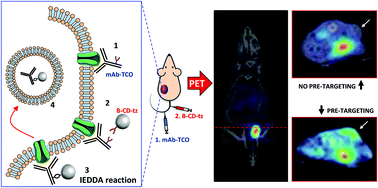Pre-targeting with ultra-small nanoparticles: boron carbon dots as drug candidates for boron neutron capture therapy†
Abstract
Boron neutron capture therapy (BNCT) is a promising cancer treatment exploiting the neutron capture capacity and subsequent fission reaction of boron-10. The emergence of nanotechnology has encouraged the development of nanocarriers capable of accumulating boron atoms preferentially in tumour cells. However, a long circulation time, required for high tumour accumulation, is usually accompanied by accumulation of the nanosystem in organs such as the liver and the spleen, which may cause off-target side effects. This could be overcome by using small-sized boron carriers via a pre-targeting strategy. Here, we report the preparation, characterisation and in vivo evaluation of tetrazine-functionalised boron-rich carbon dots, which show very fast clearance and low tumour uptake after intravenous administration in a mouse HER2 (human epidermal growth factor receptor 2)-positive tumour model. Enhanced tumour accumulation was achieved when using a pretargeting approach, which was accomplished by a highly selective biorthogonal reaction at the tumour site with trans-cyclooctene-functionalised Trastuzumab.



 Please wait while we load your content...
Please wait while we load your content...